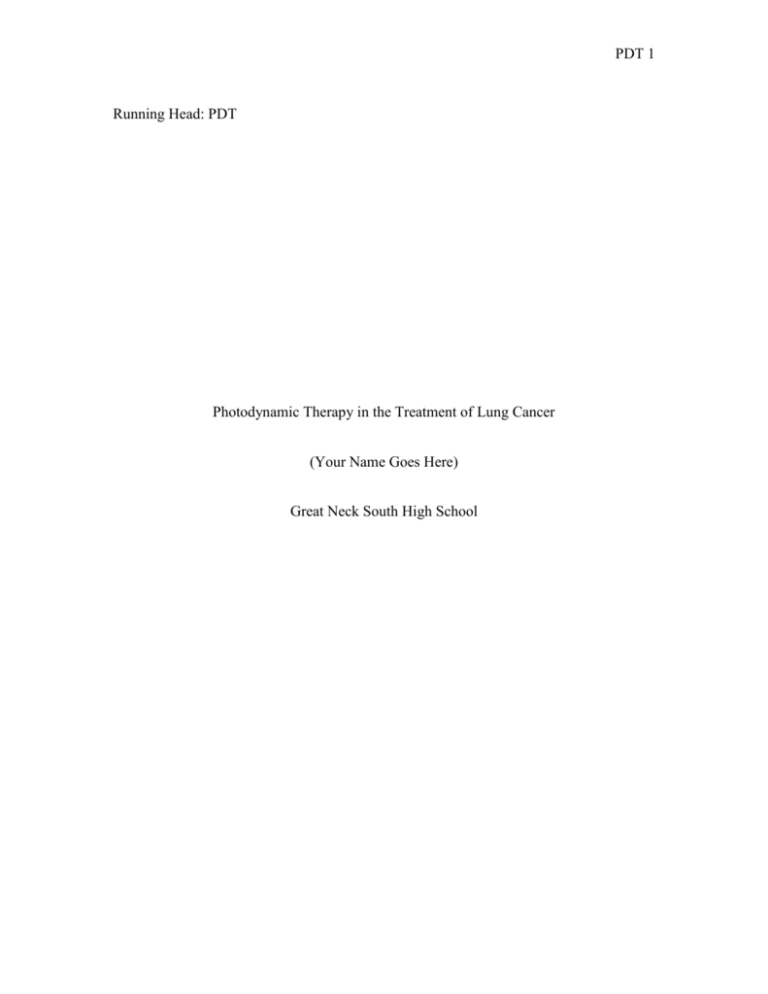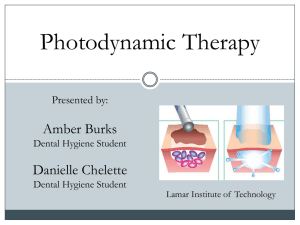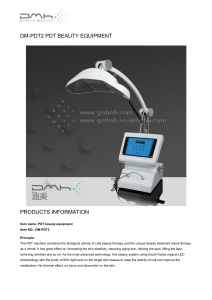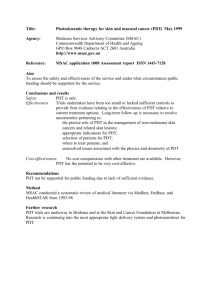Essay 2 - Great Neck Public Schools
advertisement

PDT 1 Running Head: PDT Photodynamic Therapy in the Treatment of Lung Cancer (Your Name Goes Here) Great Neck South High School PDT 2 Photodynamic Therapy in the Treatment of Lung Cancer Lung cancer is defined as the abnormal, uncontrollable growth of cells in the lungs. It is currently a leading cause of death all around the world, being the top cancerrelated killer among males in over 25 industrialized countries, and the leading cause of death from cancer among women in the United States. Rates of death from lung cancer have gone up particularly since the end of World War II due to greatly increased cigarette smoking (Lung Cancer, 2007). As numbers of diagnoses for the disease have gone up, so has the endless amount of research being done to find a cure, or at least an effective treatment. Among the forefront of emerging forms of preferred treatment today is a relatively new technique called photodynamic therapy (PDT). Several medical centers across the globe have conducted tests with this method of treatment, and there have been relatively high response rates (Mathur, Edell, Sutedja, & Vergnon, 2003). PDT is a unique method of treatment that involves the use of two key elements: a special type of light (often either a laser or a light-emitting diode) and a particular drug, called a photosensitizing agent. When applied to lung cancer treatment, PDT is a 2-phase process. The tissue surrounding the tumor is treated first with the photosensitizing agent either topically or through injection. The agent has the ability to selectively accumulate in the tumor tissue, or where there is a high concentration of abnormal cells over the course of 24 to 72 hours. It is then exposed to a specific wavelength of light, resulting in the production of a form of molecular oxygen that destroys neighboring cells (National Cancer, 2007; Moghissi, 2004). Currently, the only photosensitizing agent that has been approved by the U.S. Food and Drug Administration for use in PDT is a compound called porfimer sodium, also known as Photofrin® (National Cancer Institute, 2007). The FDA PDT 3 has so far approved the use of PDT with Photofrin® for the treatment of a number of cancers, including certain esophageal and skin cancers. The use of PDT in lung cancer treatment is relatively new (Penn Today, 2005). From 1980 to 2003, 145 patients with early-stage non-small-cell lung cancer (NSCLC) were treated with PDT (Mathur et al., 2003). The first of these studies involved the use of bronchoscopic PDT in the early 1980s at Tokyo Medical University on a patient with a very early-stage case who refused surgery. The tumor went into complete remission, and the patient survived for 4 years, dying later from non-cancer-related causes (Moghissi, 2004). Since then, extensive research has continued to be conducted in several medical facilities across the globe, including at several centers in Japan and the United States, as well as additional smaller studies in Europe and Canada. Recently published data by Corti et al. (2007) has yielded promising results. Over the course of 15 years from June 1989 to November 2004, 40 patients with recurrent NSCLC were treated with PDT and observed. The results showed a 72% complete remission rate, where no microscopically evident vestiges of the tumor remained. The subsequent mean 5-year overall survival (OS) rate was 59.55%. In addition, Furukawa et al. (2005) have offered similarly promising results in a study where 93 patients with lung cancer tumors underwent PDT treatments from 1980 to 2001. The study produced 5-year survival rates of 57.9% among patients with tumors less than 1.0 cm in diameter and 59.3% in patients with tumors greater than 1.0 cm in diameter. Furthermore, the complete remission rate in patients with tumors less than 1.0 cm in diameter was 92.8%, a remarkable number. All these figures compare very favorably with results of common surgical resection and chemotherapy procedures, which produce around 60-70% 5-year survival rates among patients with early stage NSCLC, and 10- PDT 4 20% rates among patients with more advanced, unresectable cases (Collins et al., 2007). Moreover, Friedberg et al. (2004) detailed trials that combined PDT and surgery in treating 22 enrolled lung cancer patients with pleural spread, which is when the cancerous cells the outer lung membrane. Patients with pleural spread are considered incurable. The results yielded a median survival rate of 21.7 months, compared with typical values of 6 to 9 months for similar patients treated with other non-operative methods. The results from each of these studies reflect a significantly high effectiveness of PDT in extending the lifetime of lung cancer patients. Currently, primary treatments for most cases of lung cancer continue to lean toward resection, chemotherapy and radiotherapy (Collins, Haines, Perkel, & Enck, 2007). However, the future of photodynamic therapy in treating lung cancer looks promising. It is emerging as a primary choice for treatment for early-stage lung cancer with tumors less than 1 cm in diameter, making it an attractive alternative in cases where surgical resection is either unsuited for or refused by the patient (Corti et al., 2007). However, the prospect for PDT is still highly uncertain. Though it is gaining ground, it is still most often used as a side treatment in conjunction with other more common and tested methods like chemotherapy or radiotherapy (Moghissi & Dixon, 2003). While PDT is not yet at the stage of curing cancer, it will likely continue to increase in both effectiveness and prevalence of use in the future as more research is accumulated. Word Count: 879 PDT 5 References Collins, L. G., Haines, C., Perkel, R., & Enck, R. E. (2007). Lung Cancer: Diagnosis and Management. American Family Physician, 75, 56-63. Corti, L., Toniolo, L., Boso, C., Colaut, F., Fiore, D., Muzzio, P., Koukourakis, M. I., Mazzarotto, R., Pignataro, M., Loreggian, L., & Sotti, G. (2007). Long-Term Survival of Patients Treated With Photodynamic Therapy for Carcinoma In Situ and Early Non-Small-Cell Lung Carcinoma. Lasers in Surgery and Medicine, 39, 394-402. Furukawa, K., Kata, H., Konaka, C., Okunaka, T., Usuda, J., & Ebihara, Y. (2005). Locally Recurrent Central-Type Early Stage Lung Cancer < 1.0 cm in Diameter After Complete Remission by Photodynamic Therapy. Chest, 128, 3269-3275. Friedberg, J. S., Mick, r., Stevenson, J. P., Zhu, T., Busch, T. M. Shin, D., Smith, D., Culligan, M., Dimofte, A., Glatstein, E., & Hahn, S. (2004). Phase II Trial of Pleural Photodynamic Therapy and Surgery for Patients With Non-Small-Cell Lung Cancer With Pleural Spread. Journal of Clinical Oncology, 22, 2192-2201. Lung cancer. (2007). In Encyclopedia Britannica. Retrieved September 20, 2007, from Encyclopedia Britannica Online: http://search.eb.com/eb/article-214265. Mathur, P. N., Edell, E., Sutedja, T., & Vergnon, J. (2003). Treatment of Early Stage Non-Small Cell Lung Cancer. Chest, 123, 176-180. Moghissi, K. (2004). Role of Bronchoscopic Photodynamic Therapy in Lung Cancer Management. Current Opinion in Pulmonary Medicine, 10, 256-260 Moghissi, K., & Dixon, K. (2003). Is bronchoscopic photodynamic therapy a therapeutic option in lung cancer? European Respiratory Journal, 22, 535-541. PDT 6 Photodynamic Therapy for Cancer: Questions and Answers. (2007). Retrieved October 16, 2007, from http://www.cancer.gov/cancertopics/ factsheet/Therapy/photodynamic. Photodynamic Therapy Improves Lung Cancer Survival Rates. (2005). Retrieved October 29, 2007 from http://pennhealth.com/phys_forum/ pto/jan_feb05/photo.html.








